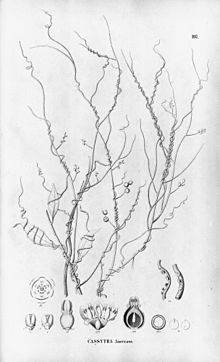Cassytha filiformis: Difference between revisions
Citation bot (talk | contribs) Add: s2cid, pmid. | Use this bot. Report bugs. | Suggested by Chris Capoccia | #UCB_toolbar |
No edit summary Tags: Mobile edit Mobile web edit |
||
| Line 35: | Line 35: | ||
}} |
}} |
||
'''''Cassytha filiformis''''', common name '''love-vine''', is a species of [[obligate parasite|obligate]] [[parasitic plant|parasitic]] [[vine]] in the family [[Lauraceae]]. The species has a native [[pantropical]] distribution encompassing the [[Americas]], [[Indomalaya]], [[Australasia]], [[Polynesia]] and tropical [[Africa]]<ref name="asdfkjlshfalshglsdfl">[http://www.efloras.org/florataxon.aspx?flora_id=1&taxon_id=200008689 Flora of North America vol 3]</ref><ref>D. S. Correll & M. C. Johnston. 1970. Manual of the Vascular Plants of Texas. University of Texas at Dallas.</ref> |
'''''Cassytha filiformis''''', common name '''love-vine''', is a species of [[obligate parasite|obligate]] [[parasitic plant|parasitic]] [[vine]] in the family [[Lauraceae]]. The species has a native [[pantropical]] distribution encompassing the [[Americas]], [[Indomalaya]], [[Australasia]], [[Polynesia]] and tropical [[Africa]]<ref name="asdfkjlshfalshglsdfl">[http://www.efloras.org/florataxon.aspx?flora_id=1&taxon_id=200008689 Flora of North America vol 3]</ref><ref>D. S. Correll & M. C. Johnston. 1970. Manual of the Vascular Plants of Texas. University of Texas at Dallas.</ref> and in the Caribbean region, it is one of several plants known as "Love vine" because it has a reputation as an [[aphrodisiac]].<ref>{{cite thesis |last1=Richey-Abbey |first1=Laurel Rhea |title=Bush Medicine in the Family Islands: The Medical Ethnobotany of Cat Island and Long Island, Bahamas |date=2012 |url=http://rave.ohiolink.edu/etdc/view?acc_num=miami1335445242 }}</ref> |
||
''Cassytha filiformis'' is a twining vine with an orange to pale green stem. Leaves are reduced to scales about 1 mm long. Flowers are borne in [[Spike (botany)|spikes]] or sometimes solitary. There are six [[tepals]], each 0.1-2.0 mm long. Fruit is a [[drupe]] about 7 mm in diameter.<ref name="asdfkjlshfalshglsdfl"/> |
''Cassytha filiformis'' is a twining vine with an orange to pale green stem. Leaves are reduced to scales about 1 mm long. Flowers are borne in [[Spike (botany)|spikes]] or sometimes solitary. There are six [[tepals]], each 0.1-2.0 mm long. Fruit is a [[drupe]] about 7 mm in diameter.<ref name="asdfkjlshfalshglsdfl"/> |
||
Revision as of 18:46, 1 June 2022
| Cassytha filiformis | |
|---|---|

| |
| Scientific classification | |
| Kingdom: | Plantae |
| Clade: | Tracheophytes |
| Clade: | Angiosperms |
| Clade: | Magnoliids |
| Order: | Laurales |
| Family: | Lauraceae |
| Genus: | Cassytha |
| Species: | C. filiformis
|
| Binomial name | |
| Cassytha filiformis | |
| SynonymsThe Plant List | |
| |
Cassytha filiformis, common name love-vine, is a species of obligate parasitic vine in the family Lauraceae. The species has a native pantropical distribution encompassing the Americas, Indomalaya, Australasia, Polynesia and tropical Africa[2][3] and in the Caribbean region, it is one of several plants known as "Love vine" because it has a reputation as an aphrodisiac.[4]
Cassytha filiformis is a twining vine with an orange to pale green stem. Leaves are reduced to scales about 1 mm long. Flowers are borne in spikes or sometimes solitary. There are six tepals, each 0.1-2.0 mm long. Fruit is a drupe about 7 mm in diameter.[2]
The 1889 book 'The Useful Native Plants of Australia records that the "This and other species of Cassytha are called " Dodder-laurel." The emphatic name of "Devil's guts" is largely used. It frequently connects bushes and trees by cords, and becomes a nuisance to the traveller. "This plant is used by the Brahmins of Southern India for seasoning their buttermilk. (Treasury of Botany?)".[5]
A 2018 study revealed how a southern Florida subspecies of this widespread species is involved in a newly discovered form of trophic interaction involving gall-forming cynipid wasps. New tendrils will actively seek out galls made by the gall wasp, Belonocnema treatae, on leaves of a host oak tree, Quercus geminata. The findings show that galls attacked by haustoria were associated with a 45% less survival rate for the wasps, suggesting that C. filiformis has an important negative impact on gall wasp survival. In the study,[6] other species of plant and wasp galls are parasitised by this plant in the southern Florida area too.



References
- ^ "Cassytha filiformis". Germplasm Resources Information Network. Agricultural Research Service, United States Department of Agriculture. Retrieved 2013-01-28.
- ^ a b Flora of North America vol 3
- ^ D. S. Correll & M. C. Johnston. 1970. Manual of the Vascular Plants of Texas. University of Texas at Dallas.
- ^ Richey-Abbey, Laurel Rhea (2012). Bush Medicine in the Family Islands: The Medical Ethnobotany of Cat Island and Long Island, Bahamas (Thesis).
- ^ Maiden, J. H (1889). The useful native plants of Australia (including Tasmania). Turner and Henderson. OCLC 670084041.[page needed]
- ^ Egan, Scott P.; Zhang, Linyi; Comerford, Mattheau; Hood, Glen R. (August 2018). "Botanical parasitism of an insect by a parasitic plant". Current Biology. 28 (16): R863–R864. doi:10.1016/j.cub.2018.06.024. PMID 30130501. S2CID 52058081.
External links
- Love Vine at Center for Aquatic and Invasive Plants, University of Florida
- Egan, Scott P.; Zhang, Linyi; Comerford, Mattheau; Hood, Glen R. (20 August 2018). "Botanical parasitism of an insect by a parasitic plant". Current Biology. 28 (16): R863–R864. doi:10.1016/j.cub.2018.06.024. PMID 30130501. S2CID 52058081.
- Cassytha filiformis in West African plants – A Photo Guide.
- Cassytha
- Plants described in 1753
- Taxa named by Carl Linnaeus
- Pantropical flora
- Parasitic plants
- Flora of Australia
- Flora of Florida
- Flora of Texas
- Flora of South America
- Flora of Central America
- Flora of Mexico
- Flora of the Caribbean
- Flora of China
- Flora of Japan
- Flora of Madagascar
- Flora of South Africa
- Flora of tropical Asia
- Flora of the Lesser Sunda Islands
- Flora of Hawaii
